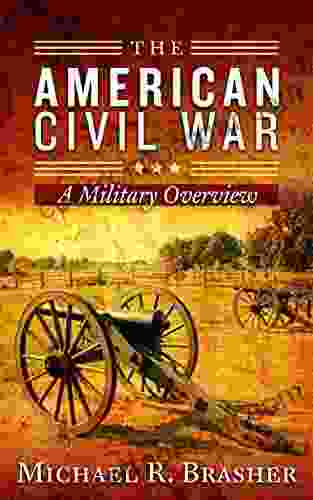The American Civil War: A Military Overview

The American Civil War was one of the most significant conflicts in American history. It was fought between the Union (the northern states) and the Confederacy (the southern states) from 1861 to 1865. The war was caused by a number of factors, including slavery, states' rights, and economic differences.
4 out of 5
| Language | : | English |
| File size | : | 2869 KB |
| Text-to-Speech | : | Enabled |
| Screen Reader | : | Supported |
| Enhanced typesetting | : | Enabled |
| Word Wise | : | Enabled |
| Print length | : | 104 pages |
| Lending | : | Enabled |
The war began in April 1861, when Confederate forces attacked Fort Sumter in South Carolina. The Union responded by blockading southern ports and sending troops to occupy southern territory. The war quickly escalated, and by the end of 1861, both sides had raised large armies.
The first major battle of the war was the Battle of Bull Run, which took place in July 1861. The Confederate army won a decisive victory, and the Union army was forced to retreat. The Battle of Bull Run showed that the war would be a long and bloody conflict.
The war continued for four years, and there were many major battles. Some of the most famous battles include the Battle of Gettysburg, the Battle of Antietam, and the Battle of Vicksburg. The Union army eventually won the war, and the Confederacy surrendered in April 1865.
The American Civil War was a watershed event in American history. It led to the abolition of slavery, the reunification of the country, and the strengthening of the federal government.
The Causes of the American Civil War
The American Civil War was caused by a number of factors, including:
- Slavery: The issue of slavery was the most important cause of the war. The southern states were heavily dependent on slavery, while the northern states were increasingly opposed to it.
- States' rights: The southern states believed that they had the right to secede from the Union. The northern states disagreed, and they believed that the Union was indissoluble.
- Economic differences: The northern states were industrialized, while the southern states were agricultural. This led to different economic interests and policies.
The Course of the American Civil War
The American Civil War began in April 1861, when Confederate forces attacked Fort Sumter in South Carolina. The Union responded by blockading southern ports and sending troops to occupy southern territory. The war quickly escalated, and by the end of 1861, both sides had raised large armies.
The first major battle of the war was the Battle of Bull Run, which took place in July 1861. The Confederate army won a decisive victory, and the Union army was forced to retreat. The Battle of Bull Run showed that the war would be a long and bloody conflict.
The war continued for four years, and there were many major battles. Some of the most famous battles include the Battle of Gettysburg, the Battle of Antietam, and the Battle of Vicksburg. The Union army eventually won the war, and the Confederacy surrendered in April 1865.
The Aftermath of the American Civil War
The American Civil War was a watershed event in American history. It led to the abolition of slavery, the reunification of the country, and the strengthening of the federal government.
The war also had a profound impact on the social and economic development of the United States. The war led to the rise of industrialization and the growth of the cities. It also led to the development of new social and political movements, such as the women's rights movement and the labor movement.
The American Civil War was one of the most important events in American history. It was a long and bloody conflict, but it ultimately led to the abolition of slavery and the reunification of the country. The war also had a profound impact on the social and economic development of the United States.
4 out of 5
| Language | : | English |
| File size | : | 2869 KB |
| Text-to-Speech | : | Enabled |
| Screen Reader | : | Supported |
| Enhanced typesetting | : | Enabled |
| Word Wise | : | Enabled |
| Print length | : | 104 pages |
| Lending | : | Enabled |
Do you want to contribute by writing guest posts on this blog?
Please contact us and send us a resume of previous articles that you have written.
 Book
Book Novel
Novel Page
Page Chapter
Chapter Text
Text Story
Story Genre
Genre Reader
Reader Library
Library Paperback
Paperback E-book
E-book Magazine
Magazine Newspaper
Newspaper Paragraph
Paragraph Sentence
Sentence Bookmark
Bookmark Shelf
Shelf Glossary
Glossary Bibliography
Bibliography Foreword
Foreword Preface
Preface Synopsis
Synopsis Annotation
Annotation Footnote
Footnote Manuscript
Manuscript Scroll
Scroll Codex
Codex Tome
Tome Bestseller
Bestseller Classics
Classics Library card
Library card Narrative
Narrative Biography
Biography Autobiography
Autobiography Memoir
Memoir Reference
Reference Encyclopedia
Encyclopedia Nancy Mohrbacher
Nancy Mohrbacher Lawrence T Orcher
Lawrence T Orcher David Hearne
David Hearne Brandt C Wible
Brandt C Wible E J Lowe
E J Lowe Suzanne W Morse
Suzanne W Morse Lawrence R Laboda
Lawrence R Laboda Bruce Jennings
Bruce Jennings C R Myers
C R Myers Frances Clamp
Frances Clamp Judy Gammelgaard
Judy Gammelgaard Transcendence
Transcendence Karen Monteverdi
Karen Monteverdi Will Chapleau
Will Chapleau Mustafa Akyol
Mustafa Akyol Bre Doucette
Bre Doucette Bryan Waterman
Bryan Waterman Bruce Zagaris
Bruce Zagaris Bryan W Van Norden
Bryan W Van Norden Bruce I Gudmundsson
Bruce I Gudmundsson
Light bulbAdvertise smarter! Our strategic ad space ensures maximum exposure. Reserve your spot today!

 Robert Louis StevensonThe Ultimate Guide for Dads Raising Daughters: Empowering Fatherhood
Robert Louis StevensonThe Ultimate Guide for Dads Raising Daughters: Empowering Fatherhood
 Jorge Luis BorgesUnveiling the Ancient African Tapestry: Exploring the Exploitation of Plant...
Jorge Luis BorgesUnveiling the Ancient African Tapestry: Exploring the Exploitation of Plant... Michael CrichtonFollow ·3.7k
Michael CrichtonFollow ·3.7k Jared PowellFollow ·5.9k
Jared PowellFollow ·5.9k Liam WardFollow ·2.4k
Liam WardFollow ·2.4k Ken SimmonsFollow ·13.8k
Ken SimmonsFollow ·13.8k Max TurnerFollow ·11.5k
Max TurnerFollow ·11.5k Marc FosterFollow ·6.1k
Marc FosterFollow ·6.1k Graham BlairFollow ·13.9k
Graham BlairFollow ·13.9k Shaun NelsonFollow ·16.2k
Shaun NelsonFollow ·16.2k

 Gary Cox
Gary CoxUnlocking Meaning and Purpose in Life: An Exploration of...
In an increasingly...

 Eric Hayes
Eric HayesMemoirs of the Early Pioneer Settlers of Ohio Illustrated
A Window into the Lives of Courageous...

 J.R.R. Tolkien
J.R.R. TolkienThe Montgomerys and Their Descendants: A Saga of Courage,...
Prepare to be...

 Avery Simmons
Avery SimmonsThe Rifle Musket: The Dawn of Modern Infantry Warfare
: The rifle musket, a revolutionary...

 Jesse Bell
Jesse BellUnlock the Power of Excel with VBA and Macros: A...
Microsoft Excel is a powerful spreadsheet...
4 out of 5
| Language | : | English |
| File size | : | 2869 KB |
| Text-to-Speech | : | Enabled |
| Screen Reader | : | Supported |
| Enhanced typesetting | : | Enabled |
| Word Wise | : | Enabled |
| Print length | : | 104 pages |
| Lending | : | Enabled |










